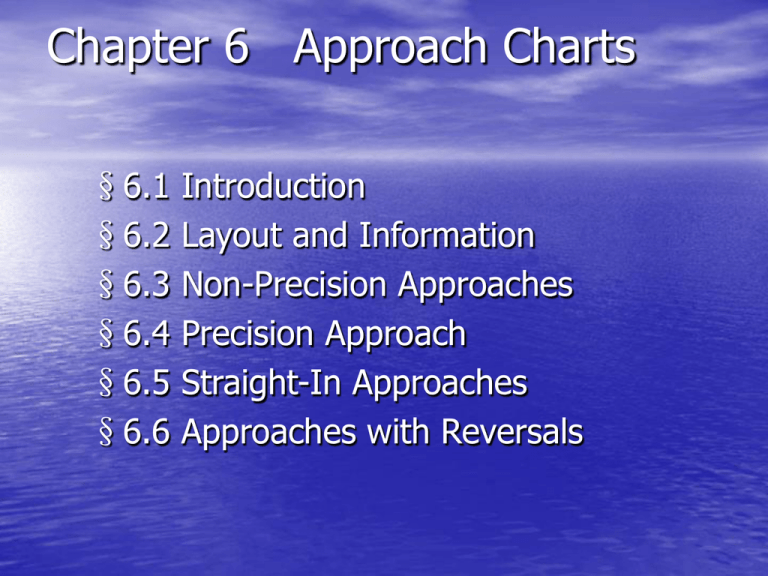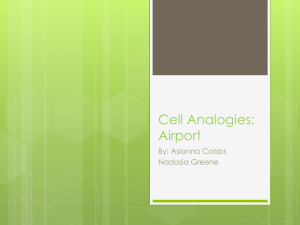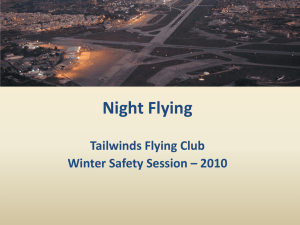Precision Approach Chart
advertisement

Chapter 6 Approach Charts §6.1 §6.2 §6.3 §6.4 §6.5 §6.6 Introduction Layout and Information Non-Precision Approaches Precision Approach Straight-In Approaches Approaches with Reversals §6.1 Introduction The standards used in designing these instrument approaches are governed by each country’s controlling civil aviation administration (CAA): • TERPS • PANS-OPS • JAR OPS §6.2 Layout and Information Jeppesen’s approach charts are designed by pilots for pilots. • The Heading • The Plan View • Profile View • Landing Minimums Heading Plan View Profile View Landing Minimum §6.2.1 Heading The information in chart heading includes: • Heading Border Data(图边信息) • Communication Row(通信频率) • Pre-Approach Briefing Strip & MSA (进近简令条和最低扇区高度) §6.2.1.1 Heading Border Data • Location Name(机场地名) • Procedure Identifier(程序名称) • Chart Index Number(进近图索引号) • Chart Date(进近图日期) • Airport Identifier and Airport Name (机场代码和名称) Procedure Identifier Location Name Procedure Identifier Chart Index Number • The First Digit represents the airport number and is an arbitrary assignment. • The Second Digit represents the chart type: 0-Area, DP, SID, STAR, Class B, etc. 1-ILS, LOC, MLS, LDA (Localizer-type Directional Aid), SDF (Simplified Directional Facility) 2-RNAV 3-VOR, VOR/DME 4-TACAN 5-RESERVED 6-NDB 7-Reserved 8-PAR, ASR(airport/airfield surveillance radar), Stand-Alone GPS 9-VOR DME RNAV, Charted Visual Flight Procedures (CVFP) Chart Date Revision Date Effective Date The chart date may be used to ensure that the chart selected is correct and current. Each chart has a chart date and, additionally, may have an effective date. Dates are expressed in the format of day, month, year. Airport Identifier and Name Airport Identifier Airport Name §6.2.1.2 Communications Row §6.2.1.3 Pre-flight Approach Briefing Strip &MSA • • • • • • • • Primary navigation aid Final approach course bearing Check altitude box Lowest minimum altitude. DA(H) or MDA(H) Airport elevation Minimum Safe Altitude (MSA) graphic Missed approach instructions Additional notes/Altimeter setting information Primary Navigation Aid Missed Approach Check Altitude Box Final Approach Course Bearing Lowest Minimum Altitude Airport Elevation Additional Notes MSA Check Altitude Box • On precision approaches, it provides the crossing altitude of the glide slope at the OM. • On non-precision approaches, it contains the altitude at the FAF. Lowest Minimum Altitude • For a precision approach, this box contains the lowest DA(H). • For a non-precision approach, it contains the lowest MDA(H) for the straight-in landing. Airport Elevation The airport elevation is the highest point of an airport’s usable runways, while the TDZE is the highest elevation in the first 3,000 feet of the landing surface. Terps Pans-ops MSA The MSA indicates the minimum altitude you can fly that will provide you with at least 1,000 feet of obstruction clearance within the given radius of the fix or facility designated below the MSA circle (when not specified, the radius is 25 nautical miles). The center of the MSA is normally the locator on ILS or localizer approaches, the VOR on VOR or VOR/DME approaches, and the NDB on NDB approaches. Missed Approach Instructions Altimeter Setting Information and Additional Notes §6.2.2 Plan View • Scale, Terrain(地形)and Elevation symbols • Navaid symbols • Flight track symbols • Airspace fix symbols §6.2.2.1 Scale, Topographical, and Elevation Symbols Man-made structure Elevation Elevation Contour Navaid Symbology Missed Approach Track latitude Approach Track Scale longitude Fix Prohibitive Area Scale The plan view is depicted to scale. Normally, this scale is one inch equals five nautical miles (1inch=5 nm). However, occasionally the length of the approach may require a different scale factor to be used. Terrain Symbols Airport Symbols §6.2.2.2 Navaid Symbology • Navaid facilities • Marker beacons • Facility information boxes Navigation Facilities Front Course Back Course Offset Facility VOR & NDB Marker Beacons Facility Information Boxes Information box (es) with shadow means that it is used as the main navaid when acting final approach. §6.2.2.3 Flight Track Symbols Approach procedure flight track Missed approach track Visual flight track High level track Magnetic Bearings and Courses True Course Magnetic Heading (Routes without radio aids guidance) Magnetic Course Radial Radial Radial Radial Course Reversals and Procedure Turns Holding Pattern §6.2.2.4 Airspace Fixes • Fixes and Reporting Points • Waypoints • Computer Navigation Fixes (CNFs) and Database Identifiers There are basically two categories of fixes, reporting points, and/or waypoints: DME Fixes Waypoints Example 1 Non-precision Approach Chart Example 2 Precision Approach Chart Example 3 Base Turn Approach Procedures Example 4 Racetrack pattern Approach Procedures Example 5 Procedure Turn Approach Chart §6.2.3 Profile View The profile view schematically(直观地) portrays a side view of the approach procedure flight path. It begins at the same location as the plan view and contains many of the same symbols; however, it is not drawn to scale. The symbols in profile view include: • Flight tracks, including bearings, distances, times, course reversals, • Airspace fixes, including FAF, stepdown fix, MAP, visual descent points, and makers • Altitudes, including the recommended descent altitude/height • Conversion table missed approach points, • Lighting and missed approach icons §6.2.3.1 Descent Flight Tracks (non) Precision Approach Glide Slope MLS Glide Path Non-precision Glide Slope High level approach track Visual flight track Outbound limited by DME Outbound limited by Time §6.2.3.2 Airspace Fixes The flight track from intermediate approach course to final approach course is defined by Marker Beacons, Fixes, Waypoints and Navaids on the profile view. MAP FAF/FAP Fix Navaid FAF/FAP For a nonprecision approach procedure, the FAF is indicated on the profile view by a Maltese Cross(马耳他叉), if specified by the state source. Stepdown Fixes After you overfly stepdown fixes, you can further descend to a minimum descent altitude. When you cannot identify a stepdown fix, you must level off at the minimum altitude specified for that fix. Only one stepdown fix normally is permitted between the final approach fix and the missed approach point. MAP The MAP (Missed Approach Point) is a point prescribed in each instrument approach procedure at which a missed approach procedure must be executed if the required visual reference has not been achieved. Precision Approach MAP Nonprecision Approach MAP For precision approaches, the MAP is the point where you reach the DA(H), while descending on the glide slope. For nonprecision approaches, the MAP occurs either at a fix defined by a navaid, The conversion table will specify the time at various speeds from the FAF to the MAP. VDP A VDP (Visual descent point) depicted by the letter V in the profile view, represents the point from which you can make a normal descent to a landing, provided you have the approach end of the runway in sight and you are at the minimum descent altitude (MDA) . A descent below the MDA should not be started prior to reaching the VDP. §6.2.3.3 Altitudes The profile view shows minimum altitudes along the flight track. All altitudes are given above QNH in feet, followed by a parenthetical(放在括 号里的) number which represent height above the airport elevation (HAA). • TDZE is the highest elevation in the first 3,000 feet of the landing surface. • TCH (Threshold Crossing Height) is a theoretical height above the runway threshold when you are established on the glide slope descent path. §6.2.3.4 Conversion Tables • For a precision approach, the table lists the glide slope angle,groundspeed and the rate of descent for the ILS glide slope (descent in feet per minute). • For nonprecision approaches, the table relates groundspeed to the distance from the FAF (the LOM or similar fix) and shows the time in minutes and seconds to fly from FAF or other specified fix to MAP. • For combined ILS and LOC approaches, only one descent table is provided when the ILS glide slope angle and the descent gradient of the LOC approach are coincidental. §6.2.3.5 Lighting Icons PAPI: Precision Approach Path indicator Standard 2-bar VASI VASI: Visual approach slop indicator Missed Approach Icons §6.2.4 Landing Minimums The landing minimums table, found at the bottom of the Jeppesen approach chart, contains two types of minimums that must both be met in order to legally complete the approach to landing: • DA(H)/MDA(H) • VIS/RVR §6.2.4.1 Type of Procedure Landing minimums are affected by any or all of the following factors: • Straight-in • Sidestep(旁侧进近) • Circle-to-Land §6.2.4.2 Type of Approach Another differentiation made in the landing minimums table is the type of approach. • Category I Precision • Category II/III Precision • Nonprecision • Multiple Approach Types Category III precision approaches typically do not have a decision altitude and require special certification for the operator and the individual pilot. Occasionally, a chart portrays more than one type of approach procedure on the same chart. In that case, multiple sets of straight-in minimums are provided. §6.2.4.3 Aircraft Approach Category The type of aircraft affects the landing minimums. The landing minimums table includes divisions for each of four aircraft categories. Each aircraft is placed into an aircraft approach category based on its computed approach speed. This speed equals 130% of the aircraft’s stall speed in the landing configuration at the maximum certificated landing weight. §6.2.4.4 Inoperative Components or Visual Aids Landing minimums usually increase when a required radio navigation component or visual aid becomes inoperative. Regulation permit you to make substitutions for certain components when the component is inoperative, or is not utilized during an approach. For example, on an ILS approach, a compass locator or precision approach radar may be substituted for the outer marker where so depicted in the profile view. Glide Slope When the ILS glide slope is inoperative, the procedure becomes a nonprecision localizer approach, raising the minimum altitude to which you can descend, and changing to a minimum descent altitude rather than a decision altitude. DME Fixes Sometimes lower minimums are allowed when you can identify a particular fix in a nonprecision final approach segment. Although DME may not be required to fly the specific approach procedure, the ability to identify a DME fix provides lower minimums. Lighting Whether or not certain lighting systems (typically approach lights, centerline lights, or touchdown zone lights) are working affects the visibility requirements for the approach procedure. Middle Marker Although in the U.S, the FAA has eliminated the penalty(处罚) for an inoperative middle marker, a few countries (such as Brazil, Chain Taipei ) continue the penalty. Altimeter Setting When an altimeter setting is derived from a remote source more than 5 miles from the airport reference point, rather than a local altimeter, the DA(H) or MDA(H) is increased by a factor that considers both the remote altimeter as well as the elevation difference between the landing airport and the remote altimeter airport. §6.2.4.5 Airport Operating Specifications There are three primary specifications that Jeppesen applies when determining minimums: • ICAO Document 9365, Manual of All-Weather Operations • Joint Aviation Regulations Operations (JAR OPS-1 Subpart E) • FAA Handbook 8260.3B TERPS §6.2.4.6 Other Factors In addition to those factors covered in this lesson, many other factors may affect landing minimums, especially those in the circle-to-land column. Frequently, these restrictions are due to critical terrain or obstacles, prohibitions to overfly nearby residence areas, or for noise abatement. Time of Day Runway Terrain Direction Example Non-precision Approach Chart Example Precision Approach Chart Example Straight-in Approach Chart Example Procedure Turn Approach Chart Example Base Turn Approach Procedures Example Racetrack pattern Approach Procedures §6.8 Circling Approach A circling approach is a procedure that involves executing an approach to one runway and then landing on another. Several situations any require you to execute a circling approach. §6.8.2 Restrictions of Circle-to-Land Restricted by Direction Restricted by Available Equipment or Navaids Restricted by Time or Weather Restricted by Aircraft Categories Limited Protected Area Example Missed Approach Procedures







